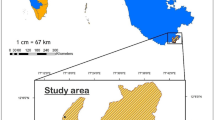Significant annual variations in population size of most species were evident with greater abundance of most species in wet years. Habitat variables, particularly vegetation structure, were also an important determinant of the abundance of most bird species and tended to mask the impacts of the land use under investigation. Several bird species had benefited from the provision of permanent water at mining and pastoral sites. Other species utilized increased nesting or feeding opportunities associated with the mining operation and increased food supply at the pastoral sites. Crested bellbirds and mixed-feeding flocks of small insectivorous birds were apparently disadvantaged by mining and hence may be useful bioindicators of mining impacts. No bird species or community parameters were identified which could serve as useful early warning bioindicators of pastoral impacts.
Similar content being viewed by others
Author information
Authors and Affiliations
Rights and permissions
About this article
Cite this article
Read, J., Reid, N. & Venables, W. ENVIRONMENTAL AUDITING: Which Birds Are Useful Bioindicators of Mining and Grazing Impacts in Arid South Australia?. Environmental Management 26, 215–232 (2000). https://doi.org/10.1007/s002670010083
Issue Date:
DOI: https://doi.org/10.1007/s002670010083




